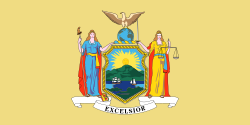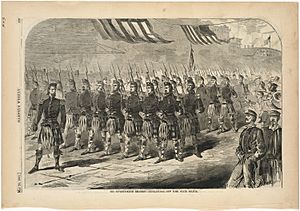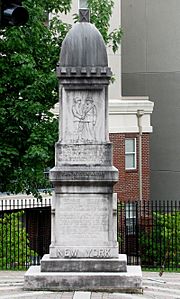79th New York Infantry Regiment facts for kids
Quick facts for kids 79th New York Infantry Regiment79th New York Highlanders |
|
|---|---|
 |
|
| Active | 1858 – 1876 |
| Country | United States |
| Allegiance | Union |
| Branch | New York State Militia (1858 – 1861, 1865 – 1876) United States Army (1861 – 1865) |
| Type | Infantry |
| Role | Highland Regiment |
| Size | Pre-War - 300 Early War - 900 Late War - 350+ |
| Part of | Commander: Lt. Col. Samuel Mackenzie Elliott Major: David McClellan |
| Nickname(s) | Highland Guard, Cameron Highlanders, Cameron Rifle Highlanders |
| Colors | Cameron of Erracht tartan |
| Anniversaries | Main anniversary on 13 May starting in 1866 with quarterly meetings held. |
| Engagements | Battle of Blackburn's Ford First Battle of Bull Run Battle of Lewinsville Port Royal Expedition Battle of Secessionville Second Battle of Bull Run Battle of Chantilly Battle of South Mountain Battle of Antietam Battle of Fredericksburg Siege of Vicksburg Jackson Expedition Battle of Blue Springs Battle of Campbell's Station Siege of Knoxville Battle of Fort Sanders Battle of the Wilderness Battle of Spotsylvania Court House Battle of Cold Harbor Siege of Petersburg |
| Commanders | |
| Notable commanders |
James Cameron, Isaac Ingalls Stevens, Addison Farnsworth, David Morrison, William H. Nobles, John More, Henry G. Heffron |
| Insignia | |
| IX Corps (1st Division) badge |  |
| IX Corps (3rd Division) badge |  |
The 79th New York Infantry Regiment was a special military group formed in New York in 1859. Before the American Civil War, it was part of New York's state army. The 79th became very famous during the Civil War for its brave service in the Union Army. They were known for their unique Scottish-style uniforms.
Contents
How the 79th New York Was Formed
The 79th New York was created in late 1858. This happened because the state of New York wanted its military groups to have new uniforms. The "Highland Guard," as they were also called, got help from Scottish groups in New York. Rich supporters like Samuel M. Elliot also helped pay for the new regiment.
Even though they were called "Highlanders," this New York group was not directly linked to the famous 79th Cameron Highlanders from Scotland. However, many of their soldiers were British Army veterans from Scottish regiments who lived in the United States. Just like the Scottish Cameron Highlanders, the 79th New York wore a special tartan pattern called "Cameron of Erracht." They even wore kilts as part of their uniforms for parades!
In 1859, the 79th New York had about 348 soldiers. They were part of New York's state army. They were trained as light infantry, which means they moved quickly. They also learned how to use heavy artillery to defend Manhattan. The regiment also helped with parades and guarded important visitors.
The 79th New York didn't know it then, but they were about to take part in almost every major battle of the Civil War. They would become one of the most well-known and traveled regiments in the Union Army.
What Did the 79th New York Wear?
When the 79th New York first practiced in October 1858, the soldiers wore their regular clothes. Their uniforms weren't ready yet. The New York state army wanted them to wear tartan trousers, not kilts. But the regiment had other plans!
Here's what their uniforms included:
Highland-Style Coat
The coat was dark blue wool with red cuffs and a blue collar. It had red trim and small white lines. The coat had 18 buttons in total. Nine large buttons went down the front. Smaller buttons were on the cuffs and back. The inside of the coat was lined with tan cotton.
Tartan Trousers
These trousers were made from the "Cameron of Erracht" tartan. The pattern was large and matched carefully. The trousers were styled like common pants from the late 1850s.
Glengarry Hat
The glengarry was a special hat, dark blue with red, blue, and white checkered patterns. It was lined with black cotton.
Leather Gear
Soldiers used common M1839 belts. They also had bayonets, which are knives attached to rifles. They carried cap pouches and cartridge boxes for their weapons.
Parade Uniform: The Kilt!
When the 79th New York was on parade, they wore kilts! This was against the wishes of the New York state army. They used the same coat and glengarry hat. But instead of tartan trousers, they had tailors make kilts from the same "Cameron of Erracht" tartan.
These kilts were unique. They were box-pleated, which is a different style than Scottish military kilts. They also had two tartan straps that buckled. Soldiers often wore suspenders with them because of how they were made.
Sporran
The sporran was a pouch worn with the kilt. It was made of white horse or goat hair. It had three black tassels and a black leather top.
Hose and Flashes
Soldiers wore red and white checkered socks, called hose. They also had "flashes," which are colorful ribbons worn below the knee.
Shoes
They wore low-cut shoes with fake buckles.
The 79th New York in the Civil War
Joining the Fight
When news came that Fort Sumter had been attacked, the 79th New York was practicing. The soldiers immediately voted to offer their help to the Governor and President Lincoln. At this time, the regiment had about 300 men. They quickly recruited 600 more soldiers. On May 13, 1861, they officially joined the army. They camped in Central Park, New York City, waiting for orders.
On June 2, 1861, the Highland Guard, with 895 men, marched through New York City on their way to Washington, D.C. In Baltimore, Maryland, they received a warm welcome. This was different from how another regiment had been treated just days before. Once in Washington, the regiment chose James Cameron as their Colonel. He was the brother of Simon Cameron, who was President Lincoln's Secretary of War. The regiment stayed at Georgetown College and practiced drills. They then moved to a camp overlooking the city. In early July, they moved into Virginia. They sang "All the Blue Bonnets are Over the Border" as they crossed the river. They were then assigned to Sherman's Brigade, ready to advance on Manassas.
First Battle of Bull Run
On July 21, 1861, the 79th New York fought in the First Battle of Bull Run. This was a very tough battle. The 79th New York faced some of the fiercest fighting and had many casualties. At first, it seemed they might miss the action. But soon, they were in the middle of it.
Their commander, Colonel William Tecumseh Sherman, sent his regiments into the fight one by one. The 79th New York was ordered forward. Led by Colonel James Cameron, they charged three times. But they made a mistake. In the smoke of battle, they thought a Confederate flag was their own and stopped firing. This was a costly error. They were hit by heavy fire. Colonel Cameron was killed during this attack.
The Highlanders had to retreat. They stayed on the hill for two more hours as other Union regiments tried to attack. Finally, everyone was driven back by Confederate soldiers. The 79th helped protect the retreating Union army. They suffered heavy losses: 32 killed, 51 wounded, and 115 captured or missing. This was a total of 198 men, about 22 percent of their strength.
After the battle, the Highlanders returned to Washington. They were put to work building defenses around the capital. This was very hard work, digging trenches and building forts with just picks and shovels.
A Difficult Time: The Mutiny
On August 14, 1861, the Highlanders, along with two other New York regiments, had a serious disagreement. They felt tricked because some soldiers who had signed up for three months were allowed to go home. But they, who had signed up for three years, were not. They also didn't like that they couldn't leave the army, while their officers could resign.
Another big problem was that they couldn't choose their new commander. Their old colonel, James Cameron, had been killed. They wanted to elect a new one, as was their custom. But instead, Isaac Ingalls Stevens, a regular army officer, was appointed. Many of their junior officers were also gone due to injuries or leaving. The soldiers refused to do their duties.
These new soldiers didn't fully understand how serious their actions were. They thought they could use their democratic rights. But military rules are different. Major General George B. McClellan quickly took action. He blamed the regiment's own officers for letting the problem grow. He sent a group of regular army soldiers, cavalry, and artillery to face the 79th. These soldiers had their weapons loaded and ready.
When the 79th New York was ordered to stop their protest, they realized they couldn't win. They quickly gave in. Twenty-one soldiers who were seen as leaders were sent to a military prison in Florida. The 79th's regimental flags were taken away by General McClellan. He kept them until the regiment proved itself worthy again. This event was a strong lesson for any other regiment thinking of similar actions.
Early 1862 Battles
In January 1862, the regiment took part in an expedition to Port Royal Ferry. In May, they saw action at Pocotaligo, South Carolina. In June, the Highlanders were part of an expedition to James Island. They fought in the Battle of Secessionville. Here, their temporary commander, Brigadier General Henry W. Benham, ordered a very risky attack on Confederate positions.
The Confederate position was surrounded by a swamp and had strong defenses. The 8th Michigan Regiment attacked first, but they were cut down by heavy fire. The 79th New York moved to support them but faced the same fate. They were trapped and had to retreat. The Union army lost 683 soldiers, while the Confederates lost only 204. The Highlanders alone lost 110 men out of 474. Despite the loss, their bravery was recognized. A Confederate newspaper even said, "Thank God Lincoln had only one 79th regiment." General Benham was removed from command for disobeying orders.
On July 12, the regiment moved to Newport News, Virginia. They arrived on the 16th and became part of the 9th Army Corps.
Second Bull Run and Chantilly
In August 1862, the regiment was involved in Pope's Campaign in Northern Virginia. Just one year after Colonel James Cameron died at Bull Run, the regiment was fighting on the same battlefield again. The Second Battle of Bull Run was unlucky for the 79th once more. Their colonel, Addison Farnsworth, was wounded.
At the Battle of Chantilly on September 1, 1862, Union forces met Stonewall Jackson's men. Brigadier General Isaac Ingalls Stevens, who used to command the 79th, now led his old regiment one last time. Under a cloudy sky, Stevens led the 79th into the attack. As they advanced, he ran past his own son, who was badly wounded. Calling "Follow me, my Highlanders," Stevens was killed instantly. He died holding the regiment's flag, almost at the same time and place as another general, Philip Kearny.
The 79th fought against the 6th Louisiana Volunteer Infantry Regiment. This battle happened during a raging thunderstorm. It became a hand-to-hand fight and ended in the rain and darkness. The Highlanders suffered heavy losses: nine men killed, 79 wounded, and 17 missing, a total of 105. General Sherman praised the 79th, saying, "I have never seen regular troops that equaled the Highlanders in soldierly bearing and appearance."
After the war, the surviving members of the 79th sent the blood-stained flag, for which Stevens had given his life, to his widow.
Later 1862 Battles
During the Maryland Campaign in September 1862, the 79th fought at the battles of South Mountain and Antietam. At Antietam, the Highlanders fought near Burnside's Bridge. They advanced despite heavy Confederate fire, pushing back some enemy troops and capturing artillery. However, new Confederate troops arrived and pushed the 79th back. Despite the intense fighting, the regiment had relatively few losses: only 40 men killed, missing, or wounded.
After Antietam, the regiment served in Maryland. In December, they took part in the Battle of Fredericksburg.
1863: Moving West
The 79th participated in the difficult "Mud March" in January 1863. In February, Colonel Farnsworth resigned due to his wounds from Second Bull Run. Lt. Col. David Morrison was promoted to Colonel.
The regiment, as part of the 9th Corps, joined the Army of the Ohio in April. Two months later, they were sent to the Army of the Tennessee to join the Vicksburg Campaign. They traveled by steamboat down the Ohio River. They stopped in Louisville, Kentucky, before arriving at the front.
A few days later, General Sherman saw the 79th New York. He was surprised to be greeted with a loud cheer. The last time he had seen them, they were new recruits complaining. Now, they were experienced soldiers who respected him.
The regiment arrived too late for the main Siege of Vicksburg. Instead, they were sent to Jackson, Mississippi, to destroy railroad tracks. In August, the regiment was back with the Army of the Ohio. They took part in Burnside's campaign in East Tennessee, fighting at Blue Springs, Lenoir, and Campbell's Station.
Battle of Fort Sanders
At Fort Sanders in Knoxville, the Highlanders helped defeat Confederate troops led by Longstreet. The fort was on top of a hill, with a 12-foot-wide ditch and a steep slope. It was defended by 12 guns and about 250 to 440 troops, with the 79th providing 120 of them.
On the cold night of November 28, Longstreet ordered a surprise attack. The Confederate troops moved quietly, but the defenders heard them and were ready. At dawn, the Confederates attacked. They struggled through telegraph wires that the Union soldiers had stretched in front of the ditch. They reached the ditch but found no ladders to climb the steep slope. The ground was frozen and slippery.
Despite this, some Confederates managed to climb up and place their flags on the fort's wall. Fierce hand-to-hand fighting followed. First Sgt. Francis W. Judge of the 79th New York bravely grabbed the flag of the 51st Georgia Regiment. He returned safely to the fort with the captured flag, even under heavy fire. Judge later received the Medal of Honor for his actions.
Longstreet's men were forced to retreat. The Highlanders cheered, yelling, "remember James Island!" The 79th had only nine casualties. The Union forces lost 20 killed and 80 wounded in total. But they caused terrible losses for the Confederates, who lost 813 men.
1864: The Final Fights
In January 1864, the 79th was joined by other regiments for about two months. They fought at Holston River and Strawberry Plains. In April, the Highlanders rejoined the Army of the Potomac. They fought in the Wilderness and Spotsylvania. At Spotsylvania, they attacked a key part of the enemy line called the "Mule Shoe."
Spotsylvania was the last battle for the original Cameron Highlanders. They again faced Longstreet's veterans and drove them back. They lost five more men killed or mortally wounded. Their colonel, David Morrison, was wounded. The regiment then received orders to leave the front lines. Their time of service was over on May 13, 1864.
The War Ends
The original soldiers whose service time had ended returned to New York City and were discharged. Fewer than 130 of the regiment's first members were left. Those who still had time left to serve were sent to guard Confederate prisoners. These men later formed the core of the "New Cameron Highlanders." New volunteers joined them to form new companies.
The new regiment served at Cold Harbor, Bethesda Church, Petersburg, Weldon Railroad, and Poplar Springs Church. In October, they became the provost guard for the 9th Corps, taking part in the Appomattox Campaign.
After Robert E. Lee surrendered, the regiment moved back to Washington, D.C. They took part in the Grand Review of the Armies on May 23, 1865. They continued their duties in Washington until they were officially released from Federal service on July 14, 1865. After this, the regiment went back to being a state militia. Ladies from the New York Scottish Society sent them new glengarry hats to wear for their return to New York City.
During the war, the 79th New York lost a total of 188 men. This included 3 officers and 116 enlisted men killed or mortally wounded. Another 1 officer and 78 enlisted men died from disease.
After the War
After the Civil War, the regiment became a state militia group again. In 1872, they changed their uniforms to match the standards of the United States Army. For example, their 1872 jacket was an artillery jacket modified to allow for a sporran. The 79th New York Highlanders were finally disbanded in January 1876. This happened because the New York State Militia was reorganized. However, the veterans of the 79th kept a strong organization going well into the 20th century.
Images for kids




